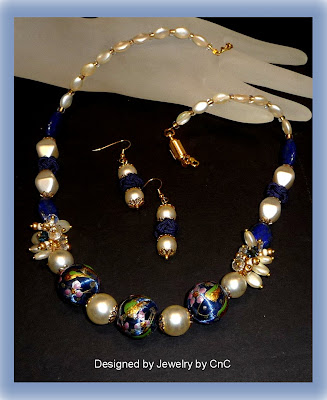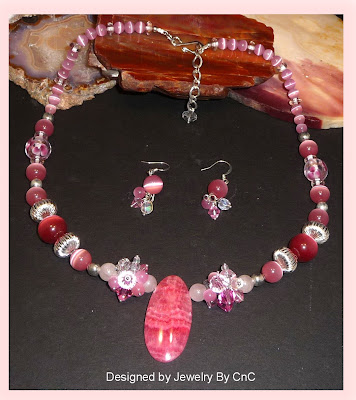Float through Summer with this colorful necklace. A 2 inch long wire wrapped purple Agate oval pendant is the main stone in this piece. The Agate is complimented with two sizes of Russian Charoite, Amethyst chips and rounds, Fluorite pebbles and a mix of crystals for a bit of sparkle. Silver Pewter accent pieces highlight this 20 inch long necklace, with a silver plated Toggle clasp. Amethyst and Fluorite dangle from the matching French Hook earrings.

SOLD Agate is a microcrystalline variety of silica, chiefly Chalcedony, characterised by its fineness of grain and brightness of color. Although Agates may be found in various kinds of rock, they are classically associated with volcanic rocks and can be common in certain metamorphic rocks. Colorful Agates and other Chalcedonies were obtained over 3,000 years ago from the Achates River, now called Dirillo, in Sicily. Most Agates occur as nodules in volcanic rocks or ancient lavas where they represent cavities originally produced by the disengagement of volatiles in the molten mass which were then filled, wholly or partially, by siliceous matter deposited in regular layers upon the walls. Such Agates, when cut transversely, exhibit a succession of parallel lines, often of extreme tenuity, giving a banded appearance to the section. Some Agates are found to be translucent when cut thin enough.
Amethyst is a violet variety of quartz often used in jewelry and decorative statues and lapidary displays. Amethyst is composed of an irregular superposition of alternate lamellae of right-handed and left-handed quartz. It has been shown that this structure may be due to mechanical stresses. Because it has a hardness of seven on the Mohs scale, Amethyst is suitable for use in jewelry. Amethyst occurs in primary hues from a light pinkish violet to a deep purple. Amethyst may exhibit one or both secondary hues, red and blue. Green quartz is sometimes incorrectly called green Amethyst, which is an actual misnomer and not an acceptable name for the material, the proper terminology being Prasiolite.
Charoite is a rare mineral, first fully described in 1978 and named for the Chara River. It has been reported only from the Sakha Republic, Yakutia, Siberia, Russia. It is found where a syenite, the Murunskii Massif, has intruded into and altered limestone deposits producing a potassium feldspar metasomatite. Charoite is translucent lavender to purple in color with a pearly lustre. However, it is a discrete mineral rather than a rock. Charoite is strictly massive in nature, and fractures are conchoidal. It has an unusual swirling, fibrous appearance, sometimes chatoyant, and that, along with its intense color, can lead many to believe at first that it is synthetic or enhanced artificially. Though reportedly discovered in the 1940s, it was not known to the world outside Russia until its description was published in 1978.
Fluorite (also called fluorspar) is a halide mineral composed of calcium fluoride. It is an isometric mineral with a cubic habit, though octahedral and more complex isometric forms are not uncommon. Crystal twinning is common and adds complexity to the observed crystal habits. Fluorite is a widely occurring mineral which is found in large deposits in many areas. Notable deposits occur in China, Germany, Austria, Switzerland, England, Norway, Mexico, and both the Province of Ontario and Newfoundland and Labrador in Canada. Large deposits also occur in Kenya in the Kerio Valley area within the Great Rift Valley. In the United States, deposits are found in Missouri, Oklahoma, Illinois, Indiana, Kentucky, Colorado, New Mexico, Arizona, Ohio, New Hampshire, New York, Alaska, and Texas. Fluorite has been the state mineral of Illinois since 1965. At that time, Illinois was the largest producer of Fluorite in the United States, but the last fluorite mine in Illinois was closed in 1995. Green and purple Flourite are the most commonly found, but all colors of the rainbow exist depending on impurities.
Crystals are also used in this set.














